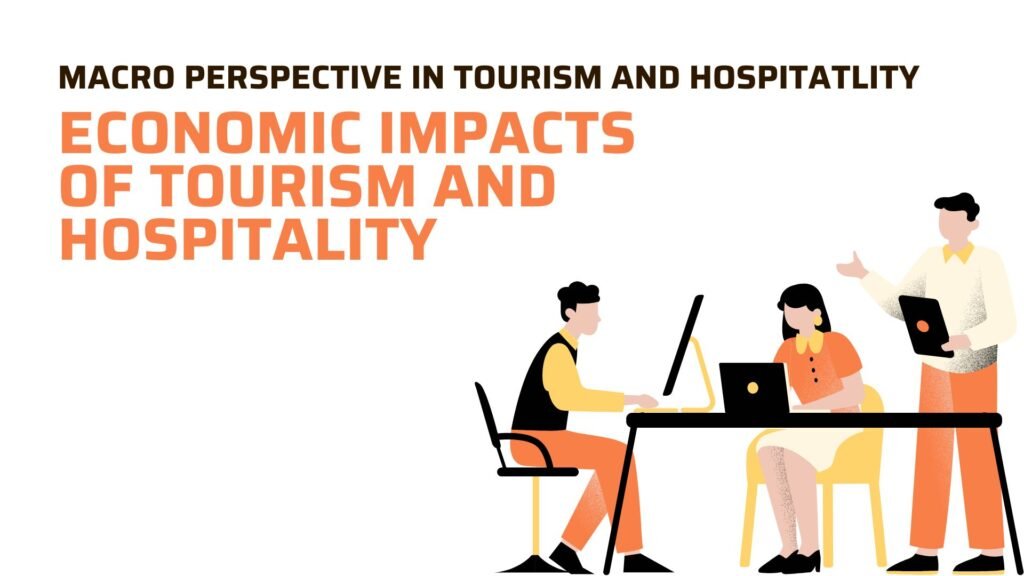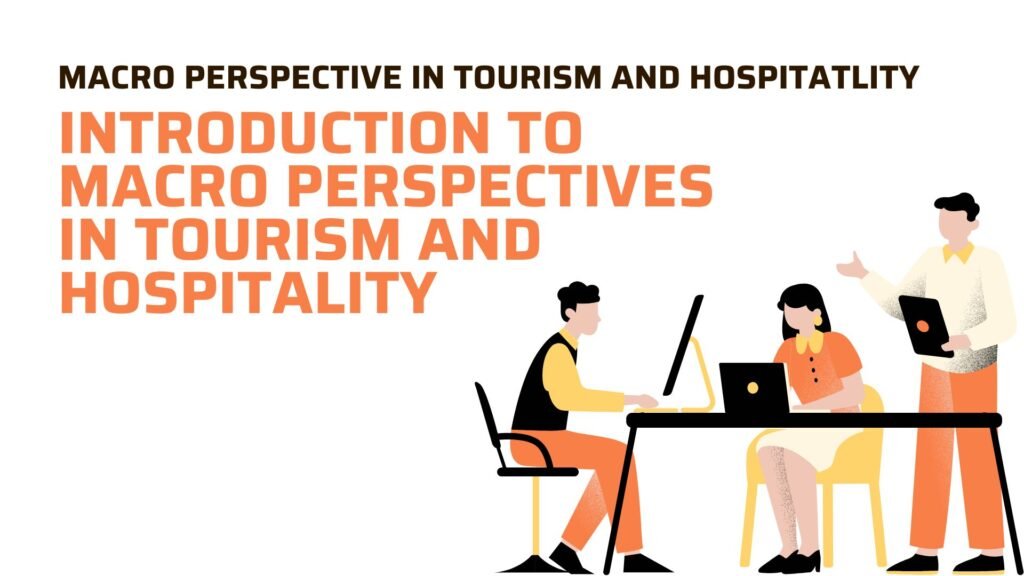
Tourism and hospitality industries are vital engines of economic growth, generating significant revenue, creating employment opportunities, and fostering infrastructural and regional development. Their contributions are felt at local, national, and global levels, often acting as catalysts for broader economic transformations. This lesson examines the key economic impacts of these industries, focusing on their contribution to GDP, employment, income generation, and foreign exchange earnings.
1. Contribution to GDP
Tourism and hospitality contribute significantly to the gross domestic product (GDP) of many countries, reflecting their importance to national and global economies:
- Direct Contribution: Revenue generated directly by tourism-related activities, such as hotel bookings, airline tickets, and entrance fees to attractions, contributes to GDP. For instance, in 2019, the tourism sector accounted for approximately 10.4% of global GDP.
- Indirect Contribution: Tourism stimulates growth in ancillary industries, such as agriculture, construction, and manufacturing. For example, a hotel’s procurement of locally sourced food and materials boosts local economies.
- Induced Contribution: Spending by those employed in tourism and hospitality industries creates additional economic activity. For instance, workers in a resort spend their wages on housing, education, and consumer goods.
Examples:
- In Thailand, tourism contributes over 15% of GDP, driven by attractions such as Phuket, Bangkok, and its cultural heritage sites.
- Small island nations like the Maldives and Seychelles rely on tourism as a primary economic driver, accounting for over 30% of their GDP in some years.
2. Employment Generation
Tourism and hospitality are among the largest global employers, providing jobs across a wide spectrum of skill levels:
- Direct Employment: Jobs created within the industry, such as hotel staff, tour guides, and airline crew.
- Indirect Employment: Opportunities generated in supporting industries, such as suppliers, transportation, and local markets.
- Seasonal Employment: Many tourism destinations experience seasonal peaks, creating temporary jobs to manage increased demand.
Key Features:
- These industries often provide entry-level opportunities, making them accessible to diverse populations, including youth and marginalized groups.
- Women comprise a significant proportion of the workforce in tourism and hospitality, particularly in roles such as housekeeping, customer service, and food preparation.
Examples:
- Globally, over 334 million jobs were supported by the tourism and hospitality sector in 2021, according to the World Travel and Tourism Council.
- In Kenya, wildlife tourism supports both direct employment in national parks and indirect employment in local crafts, transportation, and dining.
3. Income Generation
The tourism and hospitality industries contribute to income generation through various channels, driving economic development:
- Wages and Salaries: Employees in hotels, airlines, restaurants, and related sectors benefit from stable incomes.
- Business Revenues: Tourism stimulates entrepreneurship, encouraging the growth of small and medium-sized enterprises (SMEs) such as tour operators, souvenir shops, and boutique accommodations.
- Tax Revenue: Governments earn income through tourism taxes, such as bed taxes, airport fees, and park entry charges. These revenues are often reinvested in public infrastructure and services.
Examples:
- In India, the hospitality industry is a significant source of income for local artisans, whose handcrafted products are popular with international tourists.
- In Spain, which receives millions of visitors annually, tourism taxes contribute to maintaining beaches, historic sites, and cultural events.
4. Foreign Exchange Earnings
Tourism is a major source of foreign exchange earnings, which strengthen national economies and support balance of payments:
- Currency Inflows: Spending by international tourists on accommodations, transportation, and souvenirs brings foreign currency into local economies.
- Economic Diversification: For countries heavily reliant on exports or agriculture, tourism provides a supplementary revenue stream, reducing vulnerability to market fluctuations.
Examples:
- In countries like Egypt, foreign tourists visiting historical sites like the Pyramids of Giza contribute significantly to foreign exchange reserves.
- Indonesia benefits from foreign tourists visiting Bali, generating billions of dollars in foreign exchange annually.
Challenges: While foreign exchange earnings are vital, over-reliance on tourism can make economies vulnerable to external shocks, such as global recessions, pandemics, or geopolitical conflicts.
Macro-Level Economic Implications
The economic contributions of tourism and hospitality have ripple effects on broader economic development:
- Regional Development:
- Tourism often drives investment in infrastructure, utilities, and public services, especially in rural or underdeveloped areas. For example, in Peru, the popularity of Machu Picchu has spurred infrastructure development in Cusco.
- Urban Revitalization:
- Cities undergoing economic decline often invest in tourism to rejuvenate their economies. Examples include the transformation of Bilbao, Spain, with the Guggenheim Museum as a central attraction.
- Poverty Alleviation:
- Community-based tourism initiatives enable income generation for local populations, particularly in developing nations. For example, eco-tourism projects in Rwanda provide livelihoods while preserving gorilla habitats.
Economic Challenges
The economic benefits of tourism and hospitality—such as increased GDP, employment, and foreign exchange earnings—are well-documented. However, the industry also faces inherent economic challenges that can undermine its long-term sustainability and equitable impact. These challenges, including economic leakage, over-dependence, and income inequality, require strategic interventions to ensure inclusive and resilient growth.
1. Economic Leakage
Definition:
Economic leakage occurs when a significant portion of tourism revenue does not remain within the local economy. This typically happens due to the dominance of foreign-owned businesses and the reliance on imported goods and services.
Causes:
- Foreign Ownership: Many luxury resorts, hotels, and tour operators in developing countries are owned by multinational corporations. The profits generated are often repatriated to the parent companies’ home countries, leaving minimal revenue for the host nation.
- Import Dependency: Destinations reliant on imported goods, such as food, beverages, and construction materials for tourism infrastructure, lose potential earnings that could support local suppliers.
- Package Tourism: International travel packages booked through foreign agencies often result in a majority of the revenue staying outside the host country.
Impact:
Economic leakage undermines the full economic potential of tourism for host countries, particularly in developing nations, where tourism is often a key driver of GDP.
Examples:
- In the Caribbean, economic leakage is estimated to range from 70% to 90%, as foreign-owned resorts and cruise ships dominate the industry.
- Maldives, known for its luxury tourism, faces leakage from imported goods and foreign-managed resorts despite its dependence on tourism.
Solutions:
- Encouraging local ownership of tourism businesses through grants and incentives.
- Promoting local sourcing of goods and services by partnering with local farmers, artisans, and suppliers.
- Implementing policies that mandate a certain percentage of local employment and procurement.
2. Over-Dependence on Tourism
Definition:
Over-dependence occurs when a country or region’s economy relies heavily on tourism, making it vulnerable to external shocks such as pandemics, natural disasters, or geopolitical conflicts.
Causes:
- Single-Sector Reliance: Regions with limited economic diversification often prioritize tourism due to its immediate revenue-generating potential.
- Global Crises: Events like the COVID-19 pandemic, which severely restricted international travel, highlight the risks of over-reliance.
- Seasonality: Destinations with seasonal tourism face periods of high dependency followed by economic slowdowns during off-peak times.
Impact:
Over-dependence can lead to economic stagnation when tourism declines, exacerbating unemployment and reducing government revenues. It also discourages investment in other sectors, making economies less resilient.
Examples:
- Thailand: With over 15% of its GDP tied to tourism, the pandemic’s travel restrictions led to widespread economic losses and unemployment.
- Caribbean Islands: Many islands, such as Barbados and St. Lucia, experienced significant economic slowdowns during global travel disruptions due to their reliance on international visitors.
Solutions:
- Economic Diversification: Investing in alternative industries such as agriculture, technology, or manufacturing to reduce dependency.
- Domestic Tourism: Promoting domestic travel to offset declines in international visitors, as seen in Japan and India during the pandemic.
- Resilience Planning: Developing contingency plans and financial safety nets to cushion the impact of global crises.
3. Income Inequality
Definition:
Income inequality refers to the unequal distribution of tourism revenues, often favoring large corporations over local communities and small businesses.
Causes:
- Corporate Dominance: International hotel chains, tour operators, and airlines often capture the majority of tourism revenues, leaving little for local businesses.
- Low-Wage Jobs: Many jobs in the tourism and hospitality sectors are low-paying, offering limited opportunities for career advancement or financial stability.
- Unequal Resource Allocation: Investments in tourism infrastructure often benefit urban or high-profile destinations while neglecting rural or marginalized communities.
Impact:
Income inequality limits the broader economic benefits of tourism, exacerbates social disparities, and can lead to resentment among local populations.
Examples:
- Hawaii: The dominance of large hotel chains and luxury resorts has concentrated wealth among a few, while many locals face high living costs and limited financial benefits from tourism.
- Kenya: Revenue from wildlife tourism often benefits foreign-owned lodges and tour operators, with limited trickle-down to local Maasai communities living near conservation areas.
Solutions:
- Community-Based Tourism: Encouraging models where local communities manage and profit from tourism enterprises, such as homestays or cultural tours.
- Fair Wage Policies: Implementing minimum wage standards and promoting skill development to improve the earning potential of tourism workers.
- Revenue Sharing: Ensuring a portion of tourism revenues is reinvested in local development projects, such as education, healthcare, and infrastructure.
Conclusion
The tourism and hospitality industries are vital contributors to economic growth, offering significant benefits in GDP contribution, employment, income generation, and foreign exchange earnings. Their ability to stimulate ancillary industries and drive regional development underscores their macroeconomic importance. However, the challenges of economic leakage, over-reliance, and inequality must be addressed to ensure that the benefits of tourism are inclusive and sustainable. Understanding these dynamics equips stakeholders to maximize tourism’s potential while mitigating its risks, fostering long-term economic resilience.


Thanks for the recommendations shared in your blog. Yet another thing I would like to say is that fat loss is not information about going on a celebrity diet and trying to reduce as much weight that you can in a couple of weeks. The most effective way to shed weight is by using it bit by bit and following some basic suggestions which can assist you to make the most through your attempt to shed weight. You may recognize and already be following these tips, nonetheless reinforcing understanding never hurts.
Stumbled upon CODE78WIN recently and I’m hooked! They have a great selection of games and the bonuses are pretty sweet. Def worth checking out code78win if you’re looking for a new place to play!
Bigwinlogin did a great job on the platform. I was able to log in very fast and easy on different devices. Take a look at their platform here bigwinlogin
Heard 168fbet is pretty popular. What’s their deal? Good promos or just hype?
Looking for honest reviews on Lottofy? lottofyreview seems to be a spot that could help with that. Make sure to check multiple sources before making your choice. lottofyreview